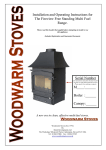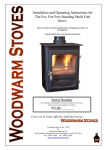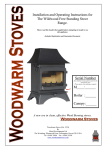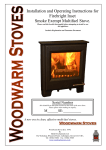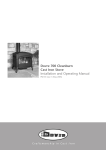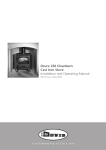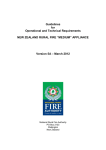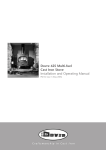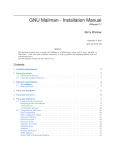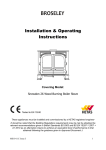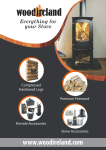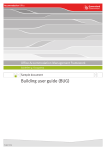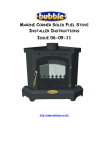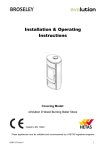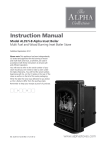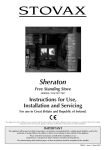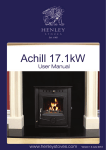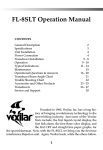Download Woodwarm Stoves 9.0Kw Operating instructions
Transcript
Installation and Operating Instructions for The Fireview Free Standing Multi Fuel Range. Please read this booklet thoroughly before attempting to install or use this appliance. Includes Registration and Guarantee Document. Serial Number Also detailed on data plate located on the back of the stove Please quote when making an enquiry M____:______ Boiler :______ Canopy:______ A new era in clean, effective multi-fuel stoves. Woodwarm Stoves Woodwarm Stoves (Est. 1974) By Metal Developments Ltd The Workshop, Wheatcroft Farm, Cullompton, Devon EX15 1RA Tel : 01884 35806 Fax : 01884 35505 www.woodwarmstoves.co.uk 1 List of Contents General Specifications Page 3 Cautionary Notes on Use Page 4 Regulations and Installation Instructions Hearth Stove Site and Minimum Clearances Chimney and Flue Air Ventilation and Free Air Flue Appliance Outlet Positions Flue Outlet Configuration Installing the Stove Baffle Internal Fireboards Fire Doors Glass Panels—Cleaning and replacement Operation of the Grate Commissioning Page 4 Page 4 Page 5 Page 5 Page 5 Page 6 Page 7 Page 8 Page 9 Page 9 Page 10 Page 10 Page 11 Page 12 Fuels for Burning on Fireview Stoves Page 12 Daily Routine, Maintenance and Servicing Page 13 Operating Instructions for the Woodwarm Fireview Stoves How Clean Burn Works Initial Lighting Lighting To Achieve Cleanburn Overnight Burning Page 13 Page 13 Page 13 Page 14 Page 15 Plumbing Notes Page 15 Ordering and Installation of Retrofit Boilers Slab Boilers Split Saddle Boilers Removing Boilers Pipe Thermostats Page 16 Page 16 Page 17 Page 17 Typical Central Heating Layouts in Conjunction with Split Saddle Boilers Typical 2 Pipe Central Heating Circuit Typical 4 Pipe Central Heating Circuit Roof Boilers Page 18/19 Page 20/21 Page 22 Aquastat Calibration Page 23 Fault Finding Page 24 Fume Emission Page 24 Fireview Double Stoves Additional Installation and Operating Instructions Page 25 The Woodwarm Guarantee Page 26 Details of Product Registration Page 27 Spare Parts Page 27 2 General Specifications - Fireview Freestanding Stoves Class 1: BS EN 13240:2001 + Amd 2:2004. For Intermittent use only. Unsuitable for use in a shared flue system. Table 1 Use only recommended fuels. Air Inlet grills must be so positioned that they are not liable to blockage. 5.0Kw 6.0Kw 7.0Kw 9.0Kw 10Kw Plus 12.0Kw 12.0Kw Plus 14Kw 16.0Kw 20.0Kw Nominal Heat Output Kw 5.0 5.8-6.6 7.0 9.1-9.3 9.6-9.8 11.6-11.5 11.5-12.0 14.0 16.0 20.1-20.3 Space Heating Kw 5.0 5.8-6.6 7.0 9.1-9.3 9.6-9.8 11.6-11.5 11.5-12.0 14.0 16.0 20.1-20.3 Efficiency %(wood) 79.7 79.7 78.5 78.5 71.7 73.6 74.0 73.6 73.6 73.6 4.3 4.3 6.1 6.1 8.0 7.4 10.4 10.9 10.9 10.9 Mean Flue gas Temp C (wood) 313 313 313 289 364 376 323 411 411 411 Efficiency %(ancit) 69.8 69.8 69.8 74.7 69.8 68.9 68.9 69.3 69.3 69.3 6.0 6.0 6.8 6.8 8.0 6.9 6.9 11.3 11.3 11.3 218 218 260 260 336 421 421 512 512 512 Model Flue Gas mass flow g/s (wood) o Flue Gas mass flow g/s (ancit) o Mean Flue gas Temp C (ancit) Weight Minimum Clearance From Inflammables (without Woodwarm heat deflector) Rear 700mm 700mm 900mm 900mm 950mm 950mm 950mm 1000mm 1000mm 1000mm Side 450mm 450mm 450mm 450mm 550mm 550mm 550mm 550mm 550mm 500mm Minimum Clearance From Inflammables (with Woodwarm heat deflector) Rear 220mm 220mm 220mm 220mm 220mm 220mm 220mm 220mm 220mm 220mm Side 110mm 110mm 110mm 110mm 110mm 110mm 110mm 110mm 110mm 110mm Recommended Refuelling Intervals Solid Fuel (hours) 1.5 1.5 1.5 1.5 1.5 1.5 1.5 1.5 1.5 1.5 Wood (hours) 1.5 1.5 1.5 1.5 1.5 1.5 1.5 1.5 1.5 1.5 368mm 368mm 368mm 430mm 483mm 483mm 483mm 558mm 588mm 635mm Flat Top 613mm 613mm 683mm 683mm 710mm 683mm 710mm 750mm 750mm 750mm Low Curved Canopy 830mm 830mm 940mm 913mm 960mm 940mm 960mm 1067mm 1067mm 1067mm High Curved Canopy n/a 926mm n/a 1044mm n/a 1060mm 1075mm n/a n/a n/a Flat Top 555mm 555mm 640mm 640mm 673mm 673mm 673mm 740mm 740mm 794mm Low Curved Canopy 604mm 604mm 710mm 710mm 750mm 750mm 750mm 813mm 813mm 865mm High Curved Canopy n/a 593mm n/a 710mm n/a 750mm 750mm n/a n/a n/a Flat Top 322mm 385mm 322mm 383mm 357mm 457mm 457mm 391mm 460mm 502mm Low Curved Canopy 331mm 395mm 349mm 410mm 398mm 498mm 498mm 386mm 498mm 540mm Maximum Log Length Overall Height Overall Width Overall Depth n/a 395mm n/a 410mm n/a 488mm 486mm n/a n/a n/a Flue Outlet Size 152mm 152mm 152mm 152mm 178mm 152mm 178mm 178mm 178mm 178mm Height to Centre of The Rear Flue 460mm 460mm 473mm 473mm 484mm 473mm 484mm 515mm 515mm 515mm 131mm 156mm 131mm 156mm 156mm 156mm 175mm 175mm 175mm 175mm Low Curved Canopy n/a 118mm n/a 118mm n/a 118mm 118mm 110mm 140mm 160mm High Curved Canopy n/a 118mm n/a 118mm n/a 118mm 118mm n/a n/a n/a Side Board( mm) (2 Required) 305 x 192 305 x 270 240 x 352 305 x 355 285 x 395 360 x 370 385 x 385 305 x 380 380 x 380 400 x 425 Rear Board (mm) 393 x 230 395 x 230 478 x 230 478 x 230 514 x 230 515 x 230 514 x 230 580 x 230 580 x 230 635 x 230 High Curved Canopy Top Flue - Centre Line To Rear Flat Top Stove Fire Boards Metal Developments Ltd reserve the right to change sizes and specifications without notice. E&OE 3 Cautionary Notes on Use De-Ashing To ensure that the stove will not over fire whilst the ashpit door is open, we would strongly recommend that de-ashing is only undertaken when the fuel load is almost exhausted, the stove is out or in a very low state. Furthermore, once the riddling has been complete it is essential to fully open the main fire door prior to opening the ashpit door. Maximum Temperature - Over-firing the Stove - Use Beyond the Rated Output The stove body is designed to run up to a maximum temperature not exceeding 700F or 400C (the stove firedoors must be kept shut at all times except when re-fuelling or de-ashing the stove). We recommend the use of a stove thermometer available from your dealer or us. There are 5 possible causes for stoves over-heating :1 After de-ashing as above, incorrect relocation of ashpit door and/or primary air vents left open. 2 The 4 levelling bolts supplied not fitted in their holes in the corners of the base of the stove (under the ashpan). 3 The ashpit door or fire door rope seals worn or damaged or missing. They should be replaced if necessary or they can be pulled out, adjusted and easily re-placed in their channels. No fixative is needed. 4 Check that the rope seal between the stove body and its canopy is in position. 5 Excessive chimney draw (the minimum flue draft for nominal heat output is:- not exceeding 0.15 mbar (0.06" water gauge)). If it is high use remedial action; either the fitting of a flue stabiliser to the flue as close to the appliance as is aesthetically possible, the fitting of a flue damper in the chimney, or a chimney cowl. (Ask your dealer or contact us for details). Chipboard and other composite wood-type materials contain corrosive additives, as do sulphurous coal products especially when mixed with wet wood, that may etch and permanently damage the surface of the glass. A reminder to the installer. All the split saddle boilers are two physically separate boilers that must be linked at the rear of the stove and tee'd off to the flow and return pipes. The Boiler circuit should have an Inhibitor added to it. REGULATIONS AND INSTALLATION INSTRUCTIONS FOR THE WOODWARM FIREVIEW STOVES All local regulations, including those referring to national and European Standards (BS 6461, Installation of chimneys and flues for domestic appliances burning solid fuel (including wood and peat) & BS 8303, Code of practice for installation of domestic heating and cooking appliances burning solid mineral fuel) need to be complied with when installing this appliance. Health and Safety at Work It is the responsibility of the installer to comply with current Health and Safety Regulations, and particular attention should be given to the following:Asbestos This stove contains no asbestos. If there is a possibility of disturbing any asbestos in the course of installation then please seek specialist guidance and use appropriate protective equipment. Handling This stove is heavy and adequate facilities must be available for all handling operations and its final manoeuvre into position. In order to lighten the stove, the main door may be removed. The baffle and grate bars can also be removed. Glass Care should be taken when handling the door that the glass is not knocked. The door is double glazed. Fire Cement Some types of Fire Cement are caustic and should not be allowed to come into contact with the skin. In cases of contact, wash off with plenty of water. Electrical If any electrical components are used in the installation they should be installed in accordance with the manufacturers installation instructions and all wiring must comply with the current I.E.E regulations and the by-laws of the local water authority. Air Supply Building Regulations dictate that an air vent of some type (usually an air brick) must be fitted into an exterior wall to allow sufficient flow of air into the fire. Air Inlet grills must be so positioned that they are not liable to blockage. This stove should not be fitted in a room where an extractor fan is in use, as this could result in flue reversal and the emission of flue gases into the room. HEARTH The stove must stand on a fireproof hearth which must be at least 127mm thick and constructed of a 4 non-combustible material. The positioning of the stove and the size of the hearth is governed by Building Regulations for Class 1 Appliances. These regulations state that the hearth must extend at least 225mm in front and 152mm to the side of the stove. This can be covered with decorative tiles so long as these are also non-combustible. SUPER IMPOSED HEARTH In certain circumstances Building Regulations allow for a super imposed hearth. This must be a minimum 12mm noncombustible material e.g. slate, glass, steel. When the stove is raised 100mm or more (with Woodwarm accessories e.g. legs, plinth, pedestal) the hearth temperature does not exceed 100°c, which complies with Building Regulations. STOVE SITE AND MINIMUM CLEARANCES There must be no combustible material (i.e. plaster board, wooden wall panels, skirting boards, beams etc) within a specified distance to the rear and sides of the stove, these can be found on table 1 page 3. The clearance between the stove and any non-combustible surface is recommended as not less than 152mm. To reduce the above clearances we recommend the use of the Woodwarm Heat Shield, which can be wall mounted to the rear or the side of the stove. CHIMNEY AND FLUE The chimney should be thoroughly swept and examined for soundness. If the chimney is not lined, then we recommend strongly that before use it is fully lined with a Class 1 Liner and insulated. It is not advisable to only partially line a chimney as this will only create further problems where the lining finishes. If there are even the smallest air breaks in the mortar, the chimney is not suitable for a wood stove. When hot flue gases rise up the chimney, it will pull cold air through any small break. This cools the flue gases at that level causing wood tar to precipitate at that point on the chimney wall. Soon this will accumulate across the chimney and therefore constrict it and stop the fire burning properly. Eventually this will not only lead to a chimney fire, but will further rot the chimney structure. If the chimney is not lined and was previously used for an open fire then there is a possibility that the higher temperatures produced by this closed appliance will loosen deposits. It will be necessary to have the flue swept and inspected by a registered sweep one month after the initial installation. In the absence of a chimney one of the following must be used either internally or externally:- a prefabricated block chimney, a conventionally constructed chimney with a Class 1 liner, or a twin walled insulated flue to BS 4543. The internal diameter must not be less than that of your particular appliance. Flues must be fitted in accordance with the manufacturers' instructions and according to local Building Regulations. If there is any doubt over the flue connection or the installation, consult your nearest professional installer, or the Building Inspector at your local council. Whichever chimney option you choose to use DO NOT FORGET TO POSITION A CLEANING ACCESS (if applicable) in your flue and chimney that is easily accessible for sweeping. Note: Clay liners can create a cool upper internal temperature which can lead to condensation problems, especially if the liners are not back insulated. If a clay liner is already in place we recommend lining with class 1 liner. For efficient stove working it is important to make sure that there is an adequate draw on the chimney. The chimney height should not be less than 4 metres measured vertically from the outlet of the stove to the top of the chimney. With a minimum flue draft reading of 0.05mbar (0.02”wg) when warm, increasing to 0.15mbar (0.06”wg) when hot. These readings should be taken using secondary air and all firedoors closed. The minimum flue size for these stoves varies according to the model, refer to the specification sheet (table 1 page 3) for the minimum flue diameter. If possible line the chimney with a flue liner that is at least 25mm (1") larger than that of your particular stove. At no point in the flue should it be below the minimum flue diameter. When the stove is to be connected to an existing fireplace, this will need sealing to the flue by a register plate, which can be mounted horizontally or vertically. This appliance is unsuitable for use in a shared flue system. If elsewhere in the house another fireplace feeds into the same chimney this must be sealed, otherwise flue gases or air may either be drawn into or escape from, the other chimney or fireplace. This would contravene Building Regulations as it is potentially very dangerous. CHIMNEYS, FLUES, COMBUSTION, AIR SUPPLY AND POSITIONING OF THE STOVE In addition to these installation instructions, Building Regulations and Local Authority By-Laws regarding flues and positioning of the appliance. (Building Regulations Document J must be observed). AIR VENTILATION AND FREE AIR: The stove requires 550 mm2 of FREE AIR space per KW input in excess of 5kw. Therefore, a 9kw input appliance requires 2200mm of free air. 9KW - 5KW = 4KW 4KW x 550mm2 = 2200mm2 There must not be a extractor fan fitted in the same room as the stove as this can cause the stove to emit fumes into the room. 5 Flue Appliance Outlet Positions Diagram 1 Point where flue passes through weather surface (Notes 1,2) A B at or within 600mm of the ridge. elsewhere on a roof (weather pitched or flat) Clearances to flue outlet at least 600mm above the ridge. at least 2300mm horizontally from the nearest point on the weather surface and: a) b) C D below (on a pitched roof) or within 2300mm horizontally to an openable rooflight, dormer window or other opening. (Note 3) Datum for horizontal measurements at least 1000mm above the highest point of intersection of the chimney and the weather surface; or At least as high as the ridge. 150mm max Datum for vertical measurements At least 1000mm above the top of the opening. within 2300mm of an adjoin- at least 600mm above the adjacent ing or adjacent building, building. whether or not beyond the boundary. (Note 3) Notes 1) The weather surface is the building external surface, such as its roof, tiles or external walls. 2) A flat roof has a pitch less than 10o. 3) The clearances given for A and B, as appropriate, will also apply. The datum for vertical measurements is the point of discharge of the flue, or 150mm above the insulation, whichever is the lower With acknowledgement to Building Regulations Document J 6 Flue Outlet Configuration Rain Cap Diagram 2 Flue Vent Minimum 4.5mtrs Flexible Liner Tee With Removable Cap Register Plate Woodwarm Rear Flue Adaptor 7 INSTALLING THE STOVE Remember to leave sufficient clearance in front of the stove for the hinged ashpit door to open fully. Place stove on chosen level hearth and remove any packaging materials. The shrink polythene can be used as a cover for the stove whilst installation is in progress as fire cement will mark the stove paint surface if left. If needed the canopy of the stove may be removed and placed to one side by lifting upwards. Ensure that the rope in the channel of the underside of the canopy is not discarded, as this is the seal between the canopy and the body of the stove. There is normally a piece of cardboard , for protection, behind the door glass. All other pieces of board in the stove are the fire boards. Turn the knob and open the main/ fire door then carefully remove it by lifting up and off its hinge pins (retaining these) and place it safely out of the way. From the front of the stove you can now remove the operating tool, flue spigot, flue blanking plate, baffle, fire boards, fire board retainer brackets (two on 9kw and Double stoves only) and the grate bars if necessary. The ashpit door can be opened, by turning the door handle anti-clockwise. The ashpan can now be removed and used for holding the grate bars if you need to remove them, which can be done easily by rotating them fully open then lifting each one out of the grate link bar, outwards and upwards. Underneath the ashpan in the base body of the stove are the levelling bolts. These bolts can be turned the other way around if necessary or used for fixing legs or plinth (optional extras) to the stove. The stove can now be levelled by using the levelling bolts or fixed to the hearth through the bolt holes. Additional brackets are supplied with the 5kw, 7kw and 10kw slim line stoves. These brackets should be fitted and used to secure the stove to improve stability. Diagram 3 Additional brackets supplied on slim line stoves only. These should be fitted and used to provide additional fixing points for securing the stove (to improve stability). The airwash cover (9kw & 12kw only) is located along the top rear of the air channel above the main door, its two pins fitting in the two holes, one at each end of the channel. If it has been dislodged in transit, ensure it is repositioned. Diagram 4 Airwash Cover (9kw & 12kw Only) Fire Board Retainer Brackets Side Fire Board 8 Replace the canopy if removed and check the base to ensure that the rope which makes the seal between the canopy and the body of the stove is in place (if needed it can be held in place with a smear of fire cement). The flue spigot supplied with the Woodwarm is either 152mm or 178mm depending on your model. It is designed to be used for top or rear mounting and is interchangeable with the blanking plate if a different flue position is required at a later date. A smear of fire cement should be applied to the flange of both the blanking plate and the flue spigot to ensure an air tight seal. Locate the blanking plate and the flue spigot in their chosen apertures and then rotate each clockwise through about 15 degrees to lock them. Ensure seal is secure and airtight. Fire cement and/or a length of fireproof rope should be used to seal the join of the flue pipe and the flue spigot, the joint between two flue pipes and where the flue pipe joins your chosen register plate. Stainless Steel self-tapping screws or nuts and set screws should be used to reinforce the above joints where applicable. Carefully remove any excess fire cement immediately to ensure no marking of the stove finish. Replace the fire board retainer brackets (9kw and Double stoves only) fire boards, baffle, grate bars and log guard followed by the ashpan and finally the main fire door. (For fitting instructions of fire boards and baffle see diagram 5 ). BAFFLE The smoke baffle sits on the rear fire board and locates on the baffle support pins in the top of the stove (front pins on two pin models) . Fit baffle as shown in Diagram 5. Ensure baffle seats squarely on rear board. INTERNAL FIRE BOARDS These stoves are for both wood and solid fuel and the interior of the fire chamber of all of them is lined with 30mm Mica based fire resistant board . There are three pieces, one at the rear under the baffle and flue outlet and one on either side or, if boilered only on the non-boilered sides of the stove. These fire boards are ready cut, to size and shape and may be packed loose to prevent damage. They are very fragile so handle with care, especially when loading with fuel. They have a relatively short life, especially when burning coal, so do inspect them regularly and replace if they begin to deteriorate by showing signs of breaking up or wearing thin. The fire board is important for efficient combustion and is not covered by any warranty as it is considered a consumable product. A table of replacement sizes is provided under Stove Fire boards on table 1 page 3. Fitting of Fire Board and Baffle Diagram 5 Baffle Support Pins Baffle Baffle Gusset Side Fire Board Rear Fire Board 9 FIRE DOORS FOR ALL MODELS Check when refitting the fire door that the rope seal on the inner face of the door is making an even contact with the stove body when the door is closed. Your New Fireview Stove has a new style door catch to make it easier and safer to use your stove. Use the tool provided to locate onto the upright part of the door catch and turn to the left to open and to the ‘lock’ position to close. If necessary this door catch can be adjusted, by loosening the lock nut (shown in blue diagram 6) with an 8mm spanner. Rotate the dome headed set screw (shown in green) anti-clockwise to tighten and clockwise to loosen seal, then re-tighten the lock nut. The ashpan door will knock the riddling lever into wood burning mode as it opens to ensure hot coals do not drop through the grate when the ash door is open. Stop pin (shown in red) holds the assembly together. It is important to keep this washer (shown in yellow) on the reverse side of the stove. Diagram 6 Important It is very unusual to have to re-align the fire door. This job is very fiddly and only to be attempted if necessary. The doors are jigged at the factory for alignment to the stove body, but should you need to adjust them use a 10mm spanner and adjust the bolts attaching the hinges to the stove body. The hinge block is fastened to the body of the stove through an enlarged hole giving adjustment horizontally, and on shim plates giving adjustment of the throw of the door to the stove body. On side mounted hinge models you will need a 13mm spanner, and 5mm allen key to adjust the allen grubscrews in the hinge block, this gives movement in all directions and is fiddly to adjust. Method clue :- Have the fire door open at 90o to the stove and then only partially loosen the fixing bolt so that the mechanism does not become loose. GLASS PANELS AND CLEANING There are two panels of glass in each door. They are made of a heat resistant ceramic product which will not break with the heat of the fire. However, it is important to maintain the movement of the glass within the door as, if the glass is restricted, it is likely to crack with the expansion or contraction of the cast door. To achieve this it has heat resistant fibre glass ladder rope around the edges and this should be replaced if it is showing signs of deterioration. The glass can be cleaned when hot without damage to the panel although care must be taken not to burn your fingers etc., also care must be taken with aerosol cleaners and cleaning cloths. We recommend the proprietary stove glass cleaners. When solid fuel is being burnt any sooty deposits on the glass can be cleaned simply by wiping with a dry cloth. If the stove glass becomes dirty this is either due to the closing of the airwash before the fuel is up to temperature and/or wood fuel is too wet. If a routine is established of hard burning on secondary air only for 20 minutes at each end of the day this will assist in keeping your glass clean. REPLACEMENT OF GLASS PANELS Carefully lift the fire door from its hinge pins and lay it down - preferably on a soft substance - being aware of the door fastening catch. The outer glass panel (furthest from the fire) is mounted on fibre glass ladder rope which should surround all the edges (diagram 7). Caution is required when replacing this glass panel as the ladder rope has a tendency to slip out of position as the glass is fitted. The second or inner panel then fits directly on top of the outer followed by the top and bottom steel glass retainer and the whole held together by the 6 x (M4 x 10mm) machine screws. It is recommended to apply some heat resistant copper grease or graphite grease to the screws and DO NOT OVER TIGHTEN THEM as the glass panels will crack. The stove requires both of these glass panels in place to achieve a clean burn state as they act in a similar way to double glazing in a domestic window. 10 Diagram 7 OPERATION OF GRATE Your stove is fitted with a multi-fuel grate (diagram 8 & 8A) which will enable you to burn wood or solid fuel equally effectively. It consists of a grate lever operating handle (shown in yellow), grate bars (shown in blue) and the grate link bar (shown in red). Once fuel is loaded on the grate the grate will remain where it has been positioned). The grate is left with the bars closed for wood and slightly open for solid fuel, to de-ash gently and NOT FORCEFULLY rotate the bars fully. Never allow ashes to accumulate underneath the grate to the point where they come in contact with the grate bars, they will overheat and distort, nor to the point where the ash will obstruct the grate link bar thus the grate bars will not be able to be rotated. DE-ASHING Using the tool provided (shown in yellow) the grate is gently and NOT FORCEFULLY rotated clockwise to open and to de-ash and anti-clockwise to close and for the wood burning mode. A GENTLE ROCKING movement will dislodge all but the largest clinkers through to the ashpan. Too much riddling/poking can result in unburnt fuel being emptied into the ash pan and should be avoided. Any clinkers should be regularly removed from the fire bed. In the larger models there are two ashpans for ease of use. The ashpan should be emptied regularly before it becomes too full. Use the operating tool to handle the ashpan, taking care not to spill the ashes as there may well be hot embers still glowing in the pan. Never allow ash to accumulate in the ashpan so that it comes into contact with the underside of the grate as this could impede the movement of the grate link bar and therefore the movement of the grate bars and will cause serious damage to the grate bars. Care should be taken that ash is cool before emptying into plastic bin liners. If the grate bars will not rotate easily DO NOT FORCE them but investigate the possible cause, i.e. clinker or nails blocking movement or too much ash in ashpan and in the bottom of stove, and remedy as soon as possible. Always refit the ashpit door properly after replacing the ashpan/s. “Tippy” ash caddies are available from your local stockist to assist in the removal of ashes from the house. Diagram 8 Diagram 8A 11 COMMISSIONING On completion of the installation and after allowing a suitable period of time for any fire cement or mortar joints to dry out, the stove should be cleaned using a soft dry cloth. Check joints and seals, especially boiler connections. Ensure that any boiler connections are the right way round. (Flows are the top connection and returns the lower). The stove can then be lit and checked to ensure that smoke is taken from the appliance up the chimney and emitted safely. The customer should be advised on the use of the appliance. On completion of the installation and commissioning please leave these operating instructions with the customer. HETAS LTD APPROVAL These appliances have been approved by HETAS Ltd as an intermittent operating appliance for burning the fuels listed below. Recommended fuels SOLID FUEL The recommended fuels for this stove are broad based long flame fuels as burnt on an open fire. ‘Homefire’ or ‘Ancit’ are such fuels. However, if you have any queries consult your Approved Coal Merchant Scheme member for types and availability. Suitable Fuels ∗ Mineral smokeless fuels which are HETAS approved and do not have greater than 20% petro coke, e.g. Ancit. Anthracite is a hard shiny coal that is naturally smokeless. Use the large nut size. ∗ Unsuitable Fuels ∗ ∗ ∗ Do not burn pure Petro coke. Do not burn household plastics and waste. Do not burn liquid fuels. WOOD If wood is the chosen fuel for your stove, ALWAYS BURN DRY WOOD. Wood burns best on a bed of ash so do be careful to retain some when de-ashing. Dry wood means that it has most definitely not more than 20% moisture content. Wood to be used as a fuel should be logged, chopped and stored in a sheltered but airy site for an absolute minimum of 12 months and preferably 24 months. Wood naturally dries at the rate of 1" per year so a 12" round will take 6 years to dry to the centre. Do not be tempted to stack wet wood on or around the stove believing this will dry the sap out of the wood. A 12" log takes approx 8 weeks in a kiln to dry to 18% moisture - so the odd hour or two on or by the stove only increases the likelihood of burning your house down! Freshly cut green wood - i.e. wood that still has sap in it - is dangerous to burn. It will cause a chimney to choke with wood tar in a few weeks with a grave risk of a chimney fire resulting. In any case, burning sap wet wood is pointless. It produces far less heat, maybe as little as 10% of that of dry wood. Treat any bought in wood as wet unless its history is known. Do not burn wet wood with solid fuel as a very aggressive acid is created which is lethal for the stove, chimneys and flues. Do not burn treated wood. Tar is caused by burning wet wood. It is brown/black in colour and may be liquid. It has an offensive smell. On the sides of the stove, flue and chimney it resembles a black sticky 'chewing gum' and can eventually block the flue ways. When it ignites, it can cause a chimney fire and be highly dangerous. Please note that HETAS Ltd Appliance Approval only covers the use of the above fuels on these appliances. HETAS Ltd Approval does not cover the use of other fuels either alone or mixed with the recommended fuels listed above, nor does it cover instructions for the use of other fuels. 12 DAILY ROUTINE , MAINTENANCE AND SERVICING When properly used a Woodwarm Fireview stove is absolutely safe. There is an operating tool provided to operate all the various controls. Do not leave the operating tool attached to the stove when the stove is in use as it will get very hot. Obviously when the stove is in use the body will be too hot to touch by hand. Children and elderly people should be prevented from touching it by accident by using a suitable fire guard. This should be manufactured to BS 6539. Combustible materials should never be left on the stove when it is alight. Linen, wool, wood and many other materials can spontaneously ignite if they become too hot. They do not have to come in direct contact with flames. Never spray aerosols near the stove when it is alight as an explosion could occur if flammable vapours or gases come into contact with naked flames. A routine should be established of :Daily - run the stove hot for a time using the procedure as explained on pages 10 and 11, along with a surface mounted thermometer to ensure optimum temperature is reached. This will assist in cleaning any marginal deposits of tar from the door glass, stove, flue and chimney internally. Check on the amount of ash in the ashpan and empty if necessary. Weekly - check seals, be they rope or fire cement, for air tightness. LUBRICATE the fire door catch and ashpit door catch if needed with a high temperature or graphite based lubricant. Ensure that the ashpit is clear of ash all the way to the rear. Clear any clinker or nails from the grate bars and from the front and rear grate bar supports. Twice yearly - check the condition of the fire boards and seals and replace if deteriorated. Remove and clean over the baffle and clear flue ways. More often if burning solid fuel. A visit from the chimney sweep will remove the small amount of ash dust which forms in the chimney if the above instructions are adhered to. The names and addresses of your local Approved Chimney Sweeps can be obtained from either of the following:Guild of Master Sweeps or The National Association of Chimney Sweeps (see page 28 for contact details). If the stove is to be left unlit for any period of time ensure the air vents are left open and the controls and door catches are well lubricated with a high temperature/graphite based lubricant or other rust preventative. Maintain the paint surface solely with a soft dry cloth and nothing more. The paint used is a durable heat proof paint. It is, as a consequence, porous and is not waterproof. Before re-lighting the stove after a long period out of use, check that all flue ways are clear of obstructions. OPERATING INSTRUCTIONS FOR THE WOODWARM FIREVIEW STOVES Before lighting check with the installer that the work and checks described in the previous pages of this booklet have been carried out correctly and that the chimney is sound, has been swept and is free from any obstructions. HOW CLEAN BURN WORKS The Fireview range of stoves utilise long preheated air inlet ducts venting the air to the stove at the front top of the door aperture. This method of air inlet builds an 'Air Curtain' over the glass and prevents all but a little of the normal tar deposits from condensing on the glass of the stove, and causes all, but a small proportion, to be burnt in secondary combustion, hence the 'CLEAN BURN' application. INITIAL LIGHTING Note The paint used for finishing the stove will emit fumes as it "cures" when first fired, and maybe on the second firing, as the body of the stove reaches operating temperature. Therefore ensure the room is well ventilated. As part of the process the paint will soften whilst “curing” so avoid touching as this will severely mark the finish. LIGHTING Open the air control lever on the left hand side of the stove by pushing it down. Open the air control knobs in the ash pit door by sliding them to the left. Make sure that the exterior of the stove is thoroughly cleaned using a dry cloth. The stove can be lit using paper, dry kindling, and/or fire lighters. Place the paper and kindling or fire-lighters on the grate and cover with wood or a 50mm layer of solid fuel. Light the fire and close the stove doors; wait until the fuel is well alight then load fuel and adjust the air controls to suit as in the following section. 13 Diagram 9 Close Air Bleed Hole Open Open Close TO ACHIEVE CLEAN BURN This section applies for the burning of dry wood and to broad based long flame path solid fuels. Take some time to familiarise yourself with the air controls of the stove (diagram 9) to achieve the clean burn state that these stoves are renowned for. The air wash is controlled by the lever on the top left hand side of the stove. When the lever is in the UP POSITION the air wash is closed. When the lever is in the DOWN POSITION the airwash is fully open. A) When lighting or refuelling the stove allow it to reach operating temperature every time, before attempting to close the air wash control lever. The glass will get dirty if the stove body has not reached the optimum temperature first and clean burn will not be achieved. We recommend that you use a magnetic surface-mounted thermometer (which can be purchased from your supplier or from ourselves) to achieve this. Place it on the body of the stove at the front right hand side just above the door hinges. Regard the bottom ashpit door air slider control like the choke on a car i.e. close them as soon as the stove is warm. B) Leave the top air control open for about 20 minutes until the surface temperature of the stove body has reached a temperature of 250-280oC (450-500o F), as shown by the thermometer. Slowly close the air wash lever. Although use of the ashpit door air slider will increase the draw of the fire, prolonged or excessive use of this under draught will cause dirtying of the glass, and can lead towards excessive over firing of the stove, therefore reduce under draught as soon as is practical. C ) When refuelling the stove, first open the top air control to increase the draw of the fire and allow the chimney to warm up, this will draw any smoke/fumes up the chimney when you open the main door. To maintain the hot air flow from the front of the stove to the rear, drag any unburnt fuel to the front and add new fuel to the rear. Try and keep the fuel at least 25mm from the door glass when the door is closed and repeat the procedure in B . For recommended refuelling intervals see table 1. Time spent now will reward you and remarkable results should be achieved. This will be even more apparent to you if you have previously owned a conventionally draughted stove. It will take a few loadings and firings before you become familiar with the air vents and amount of fuel necessary to achieve the burning rate you require. Try to load the stove with fuel enough i.e. not too small a load and not too large a load. To be avoided at any time is loading the stove up and immediately closing all the air controls. 14 Air Bleed Control A small air bleed hole adjustment is provided, it is either located on the airwash lever, or behind it. Its function is to allow you to “Set” the stove to the chimney draught. Open it fully and over the first couple of extended burning periods, monitor the result of your stove's slumber. If it fails to stay alight long enough, by burning through all the fuel too quickly, reduce the setting until you are happy. When you are, tighten up the self tapping screw, so that in future when you fully shut the airwash lever this hole will allow the stove to remain just open. Chimneys with a high draw may require this small air bleed hole to be closed. Chimney Fires If the chimney is thoroughly and regularly swept, chimney fires should not occur. However, if a chimney fire does occur turn the air control setting to the minimum, and tightly close the doors of the stove. This should cause the chimney fire to go out in which case the control should be kept at the minimum setting until the fire in the stove has gone out. The chimney and flue ways should then be cleaned. If the chimney fire does not go out when the above action is taken then the fire brigade should be called immediately. After a chimney fire the chimney should be carefully examined for any damage. Expert advice should be sought if necessary. Boilered Stoves Note:Cleanburn will be a little more difficult to achieve with boilered stoves. However perseverance to achieve as high combustion temperatures as possible will assist in keeping the glass clean. EXTENDED BURNING PERIODS When burning solid fuel the stove should be de-ashed, the bottom air controls opened for a brief period and when the fire is burning brightly it should be loaded with fuel without dowsing the flames. The bottom air controls should then be closed. The stove will burn more slowly if a smaller size of solid fuel is used. The opposite is true when burning wood, thus if longer burning times are required use dry large logs of a hard wood rather than small ones, remembering to keep a bed of ash above the grate bars. Some fuels need more air than others to tick over, some experimentation will be necessary to find the right setting. Do not mix solid fuel with wet wood in an attempt to achieve long periods of burning. Remember to allow the stove to reach operating temperature before closing air controls. Plumbing notes Please read these notes prior to installing your Woodwarm boilered stove ∗ ∗ ∗ ∗ ∗ ∗ ∗ ∗ ∗ ∗ A boilered stove will have a lower combustion temperature than a dry stove and will not reach the clean burn state as readily. Always site the circulating pump on the return. Do not fully pump a solid fuel stove as it is refuelled on a two hour refuelling cycle and may not be able to get it’s heat load up to temperature when fully pumped When a pump is used on the heating circuit ensure that it’s action is controlled by pipe thermostats to stop it circulating water which is under 50°C Ensure one third of the system can rise to a gravity section of the circuit. Do not pressurize the system, always use an open vented circuit. If combining two or more heat sources think of using a “Link Up” Neutralizer as part of the circuit, it will assist in even distribution from both heat sources. Where there are two pumps in the system, possibly as above, there will need to be a three channel programmer incorporated such as the Honeywell ST699. Do not directly plumb under floor heating into the circuit. For under floor heating there will need to be a heat store (Thermal Accumulator, thermal store) A Heat Store is a very efficient way of using heat. A stove can be fired flat out to heat it, which is the most efficient way to use the boilered stove. The stove can then be allowed to go out, with the electric controls distributing mains pressure hot water and circulation water as and when required. In choosing a heat store look for at least 100mm of insulation. It can be plumbed directly to the stove but it must have the relevant safety measures and it must be a minimum 1800mm above the stove. For size and heat calculations use 10 litres per square metre One shower = 20 minutes = 10kw 40W/sq mtr new house 60W/sq mtr old house 80W/sq mtr draughty old mansion Try www.heatweb.com for more details on Heat Stores 15 ORDERING and INSTALLATION OF RETROFIT BOILERS All the models have a variety of boilers that can be retro-fitted and have pre-drilled holes in the body and these are covered with blanking plates which can be knocked out using a hammer (do ensure you have the right holes by offering the boiler up to the holes prior to removing them) and when ordering boilers for retro-fit please state your stove model as some need a change of baffle. i.e. for the 53000 Btu split saddle boilers in the 20kw. Boilers replace the fire boards and depending on the size of boiler to be fitted, remove the relevant board(s) or part thereof before fitting the boiler(s). With slab boilers the rear fire board may be larger than the boiler; cut the appropriate amounts from the fire board and fit them back either side of the boiler. All the boilers in the free standing models have 1" Male BSP stubs. SLAB BOILERS The slab boilers available for your stove are detailed in the current brochure under general specifications. They are available in stainless steel for 'Direct' Cylinders or steel for 'Indirect' Cylinders and have two 1" Male BSP stubs. To fit the boiler remove the fire board and remove the relevant blanking plates. The two stubs are passed through the stove body holes and the nuts and washers are sealed (with fire cement or high temperature mastic, where the stubs come through the body) and tightened on the rear of the stove body. The higher boiler stub is for the gravity flow which should rise immediately from the boiler in 28mm pipe and the lower is for the return. SPLIT SADDLE BOILERS Split saddle boilers are available only for the Fireview’s 6Kw, 9Kw, 12Kw, 12Kw Plus, 16Kw and 20Kw, and are supplied as two separate L-shaped boilers. It is imperative that the plumbing of these boilers is done with the utmost care and full notice is taken of the above fact. These boilers are available in steel for 'Indirect' Cylinders only and each individual boiler has two 1" Male BSP stubs. To fit the boiler remove the fire board and the relevant blanking plugs from the back plate of the stove. The two stubs are passed through the stove body holes and the nuts and washers are sealed (with fire cement or high temperature mastic, where the stubs come through the body) and tightened on the rear of the stove body. The two halves must be horizontally joined in the following manner (diagram 10)- connect the two higher outlet stubs for the single 28mm main gravity flow which should rise immediately from the boiler, connect the two lower outlet stubs and bring your 28mm return to this link. Diagram 10 PLUMBING DIAGRAMS Diagrams 12 & 13 - Page 18 & 20 and Diagram 14 - Page 22 16 REMOVING BOILERS Should you wish to remove your boiler(s) we can supply blanking plugs, fire boards and a new baffle. If the roof boiler is to be removed/replaced please quote Stove Model and choice of canopy required. Should you wish to add or change boilers - for the available sizes and outputs, contact your dealer or us for advice. PIPE THERMOSTATS Every stove with boilers intended for more than domestic hot water should have an indirect copper cylinder, a central heating circulating pump and at least 30% of the heating load should thermo-syphon/gravitate to protect the system in the event of a electrical power failure or circulating pump failure. There should be three essential devices fitted to maintain safety, longevity of boilers and to comply with the guarantee conditions of Woodwarm Stoves. 1 A high temperature Pipe Thermostat. This is clamped on to the main 28mm gravity flow water pipe and switches the pump on when the boilers/pipe temperature rises. It should be set at between 85oC and 95oC and thus ensures that the copper Cylinder hot water does not boil but is dissipated safely around the radiator circuit. 2 A low temperature Pipe Thermostat. This is clamped on to the main 28mm return pipe and should be set at between 45oC and 55oC and thus switches the pump off when the temperature of the water returning from the system/hot water copper Cylinder to the boilers begins to fall. It ensures that cold water does not circulate through the stove boilers and the circuit as this would:a. Allow the heating circuit to rob the heat from the hot water copper Cylinder b. Cause acid condensation to form on the boilers inside the stove and them to fail early c. Create a cold flue/chimney and the associated condensation/tar problems The objective is to have a continuous circuit of warm-hot water circulating from the boilers in the stove to the copper cylinder and when the pump is on, continuing this around the radiators. Therefore the stove must be run at a sufficiently hot temperature to sustain this. It is important that the boilers' output, as in the General Specifications, is enough to do this and calculations should also take into account the kilowatt room output of the stove when the boilers have been fitted. Line Diagram 11 Neutral Pipe Thermostats - Wiring Diagram C High Limit 90oC 1 2 If time clock and/or room thermostats are to are fitted then remove the link between A & B and replace it with the device. NB. Time clocks and room thermostats are only appropriate for Woodwarm Stoves which have an Aquastat Control fitted. A B Pump C Low Limit 50oC Connections 1 2 C - Common 1 - Break on Rise 2 - Make on Rise 3 A Injection Tee To prevent the 70% of the central heating load from gravitating around the radiator circuit and creating cold water problems (as under 2a & 2b above) when the circulation pump is off. 17 Typical 2 Pipe Central Heating Circuit in Conjunc Vent Pipes 22mm Expansion Tank Mains Water Gravity Circuit Should be 30% of the Total Boiler Load 28mm Cold Fill Dead Loop 28mm High Pipe Stat 28mm o 90 C (Injection Tee 28mm) Direction of Flow 28mm to 15mm Reducer 50oC Drain Point 18 Low Pipe Stat Circulation Pump ction with Split Saddle Boilers (Indirect Cylinder) Diagram 12 Cold Water Tank Hot Water For Taps 19 Typical 4 Pipe Central Heating Circuit in Conjunc Vent Pipes 22mm Expansion Tank Mains Water Gravity Circuit Should be 30% of the Total Boiler Load 28mm Cold Fill Dead Loop 28mm High Pipe Stat 90oC 50oC Low Pipe Stat 20 Drain Point Circulation Pump ction with Split Saddle Boilers (Indirect Cylinder) Diagram 13 Cold Water Tank Hot Water For Taps 21 ROOF BOILERS - ONLY available in conjunction with the split saddle boilers Roof boilers are constructed with or without a top flue outlet and this must be specified, along with the stove model when ordering. They have two 1" Male BSP stubs. They are used only in conjunction with the split saddle boilers for your stove model, to increase the boiler output and reduce room output. Plumbing this extra boiler with the split saddle boilers requires the main gravity-flow to be taken from the split saddle boilers' top tapings' link to the lower tapping of the roof boiler and then continued on from the higher tapping of the roof boiler upwards. Therefore the main gravity-flow runs from the link of the upper tapings of the split saddle boilers, through the roof boiler and upwards. All this pipe work should be in 28mm pipe to the cylinder and gravity/heat leak radiator. Fitting and Plumbing of Split Saddle Boilers with Roof Boiler Diagram 14 Gravity Load 30% of total boiler output. Plumb Gravity Flow in series through Roof Boiler if fitted. 2 Pipe Heating Circuit 4 Pipe Heating Circuit Hi Pipe Thermostat Hi Pipe Thermostat 28mm pipes 90oC 90oC 28mm pipes Remember to link both halves of the Split Saddle Boilers Lo Pipe Thermostat 50oC Lo Pipe Thermostat 50oC Drain Point Drain Point Remember to link both halves of the Split Saddle Boilers 22 AQUASTAT CALIBRATION Only applicable for the FIREVIEW 20KW fitted with the 53000Btu split saddle boiler This stove has an Aquastat fitted as standard (diagram 15), and in conjunction with High and Low pipe thermostats assists the stove to maintain the boiler temperature by automatically allowing either more or less air into the fire chamber via the airwash depending on the Control Knob setting. FITTING INSTRUCTIONS IF NOT FACTORY FITTED The copper capillary wire and phial are delicate and will be easily damaged if handled roughly. With the two M6 x 10 set screws and washers, fit the Aquastat control to its box at the rear of the 20Kw Stove, carefully fit the phial flat end first into its boiler tapping. When viewed from the rear this is located immediately below the right hand flow tapping and to the left of the Aquastat box, it is the tapping which is flattened at its top and has a horizontal hole through it for the split pin to hold the phial in place. CALIBRATION INSTRUCTIONS The Aquastat control must be calibrated. It is the round flapper plate on this device that must be set. With the stove alight, the boiler temperature at 550C and the control knob in the middle (4-5) of it's range, the flap plate should be just on the point of closing, adjust the position of the flap plate by means of the 5mm set screw and nuts either side of the flap plate until this is achieved and then tighten the nuts. OPERATION Close both primary and secondary air inlets and set thermostat dial to number 6. This will now allow the stove to work thermostatically according to the water temperature. Adjust the thermostat as required to suit demand. Diagram 15 Boiler Temperature Control Knob Aquastat Phial Sensor / Phial Socket Threaded Adjustment Screw Flapper Plate Copper Capillary Tube 23 FAULT FINDING A) Stove smokes on lighting or when fire door is opened Flue ways blocked - sweep chimney and flue. Baffle incorrectly fitted. Adverse wind conditions, or down draught - check height and diameter of chimney. Flue not connected (or not sealed) to appliance or chimney . B) Fire fails to burn overnight - fuel burnt through Insufficient dry fuel. Air supply too great for fuel load. Fire door or ash door seals damaged. Door adjustment too slack. Door glass sealing rope damaged or missing. Insufficient bed of wood ash (when burning wood). C) Fire fails to burn overnight - fuel not burnt Insufficient air supply for fuel load. Wood fuel beyond 18% moisture content and therefore too wet. All section A applies also. Grate closed or ashpan full whilst burning solid fuel. Fuel load not raised to a high enough temperature before closing to slumber. Boiler pipe thermostats set too low or not fitted at all. D) Stove cannot be closed to slumber and fuel burns too fast Air controls open. If the above are closed and/or shut then air is getting into stove from elsewhere. Check if door, glass and ashpit door rope seals are damaged or not seating. If rear flue outlet is being used, is the flat top / canopy seated on correctly. Check all flue connections are airtight. Check if flue blanking plate is airtight. Go through installation procedures and cautionary notes. Chimney draw too fast - fit flue stabiliser. E) Door glass sooting up Allow stove to reach body temperature before closing air wash. Air inlets on ashpit door open, whilst air wash control is shut. Use bottom air as choke only - i.e. minimal use. Fuel load too close to the door. F) Boiler fails to reach operating temperature Fuel load too wet. Boiler load too great - check Btu output required for circuit. Fit High and Low pipe thermostats. Fuel load too small for demand. Insufficient air supply for fuel load and demand. G) If the stove gets too hot in the room whilst the boiler output is too low Consider fitting a roof boiler - see your dealer for details or contact us. FUME EMISSION WARNING NOTE: WHEN PROPERLY INSTALLED AND OPERATED THIS APPLIANCE WILL NOT EMIT FUMES OR SMOKE TO THE ROOM. OCCASIONAL FUMES FROM DE-ASHING AND RE-FUELLING MAY OCCUR. PERSISTENT FUME OR SMOKE EMISSION TO THE ROOM MUST NOT BE TOLERATED. IF EMISSION DOES PERSIST THEN THE FOLLOWING IMMEDIATE ACTION MUST BE TAKEN. A OPEN ALL DOORS AND WINDOWS TO VENTILATE THE ROOM B LET THE FUEL OUT AND SAFELY DISPOSE OF FUEL FROM THE APPLIANCE C CHECK FOR FLUE OR CHIMNEY BLOCKAGE AND CLEAN IF NECESSARY D DO NOT ATTEMPT TO RELIGHT THE FIRE UNTIL THE CAUSE OF THE FUMES HAS BEEN IDENTIFIED, IF NECESSARY SEEK PROFESSIONAL ADVICE 24 FIREVIEW DOUBLE STOVES ADDITIONAL INSTALLATION AND OPERATING INSTRUCTIONS HEARTH The stove must stand on a fireproof hearth which must be at least 127mm thick and constructed of a non-combustible material. The positioning of the stove and the size of the hearth is governed by Building Regulations for Class 1 Appliances. These regulations state that the hearth must extend at least 300mm in front and 150mm to the side of the stove. This can be covered with decorative tiles so long as these are also non-combustible. There must be no combustible material (i.e. wooden wall panels, skirting boards, beams etc) within 700mm of the rear of the stove. The area of hearth will need to be correspondingly deeper, with the stove needing two front extensions of 300 mm. FIRE BOARD RETAINER BRACKETS These are the two angled pieces of steel with two holes in each bracket which are fitted onto the baffle support pins either side of the stove before locating the baffle. BAFFLE AND FLUE OUTLET The baffle hangs over the fire board retainer brackets, on the baffle support pins, two on either side of the stove. The dip in the middle of the baffle should be under the fixed top flue outlet. Diagram 16 Baffle Baffle Support Pins Fire Board Fire Board Retainer Brackets DE - ASHING The double depth stove has two ashpans - one located at either end. The single depth stove only has one ashpan which can be used from either side of the stove (depending on which way it has been placed into the ashpit). AIR CONTROLS The main airwash controls are linked together to allow for equal and even air flow throughout the stove. FUEL LOADING When loading fuel be careful to have a fuel bed distributed evenly across the grate of the stove. Bear in mind this double stove will reach only a semi-cleanburn state if the fire is just at one end of the stove. GRATE The double depth stove has a double riddling grate, each grate has to be operated from each respective end of the stove. The grate in the single depth double can only be operated from one side. FLAT TOP / CANOPY Please note that all flat tops and profiled flat tops are welded to the stove body, only low and high canopies can be removed from the stove to lighten it whilst moving it. 25 THE WOODWARM STOVES GUARANTEE Metal Developments Ltd offer a five year guarantee which covers the main structure of the stove including the construction and quality of workmanship. In the unlikely event of any failure we will replace any defective part free of charge, labour cost excluded. This guarantee is invalid if the stove is not assembled, installed or operated as per these instructions or does not comply with current building regulations and any regional legislation in force at the time. Metal Developments Ltd does not guarantee the onsite assembly, installation or operation of the stove. Please seek advise from your stove supplier / installer for any relevant guarantees applicable to the installation. Metal Developments Ltd will not be held liable for any consequential or incidental loss, damage or injury, however caused. Claims under this guarantee should be first made through your Woodwarm Stove retailer. This guarantee is only applicable in the UK. Nothing in this guarantee shall effect your statutory rights. Exclusions The following consumable parts are not covered by this guarantee : Swivel Fire Bars, Logguard, Baffle Plate, Operating Tool, Fire Boards, Glass Panels and Door Seals. Paint is also excluded from the guarantee as it will eventually deteriorate due to the normal working of the stove. Your assistance is requested by filling in and returning the product Registration and Guarantee Form, this will help maintain our records and assist us in identifying your stove in the unlikely event of any problem occurring and also when you need to order any spare parts. 26 DETAILS OF PRODUCT REGISTRATION FOR OWNER RETENTION MODEL NUMBER AND SERIAL NUMBER OF STOVE M --(Found on the data plate located on the pull-out plate on right hand underside of stove also on the front of this booklet) Date of Purchase Date of Installation SUPPLIERS ...... /...... 20...... ...... /....... 20...... DETAILS Suppliers Invoice Number................................................. Name................................................................................................................................................................... Address.........................................................................................................................................................….. ....................................................................................................................................................................…….. ....................................................................................................................................................................…….. Phone Number......................................... INSTALLERS DETAILS Name................................................................................................................................................……………. Address..............................................................................................................................................………….. .......................................................................................................................................................………………. .......................................................................................................................................................………………. Phone Number.......................................…HETAS Registration Number……………………………………… SPARE PARTS Use only Metal Developments Ltd approved replacement parts. 14mm Main Fire Door Rope 14mm Ash Door Rope Door Glass Ladder Rope Door Glass (2no per stove) Fire Boards Operating Tool Grate Link Bar Swivel Grate Bar Door Hinge Pin Ash Pan Baffle Log Guard State model State model State model State model and number required State model and see chart (30mm) State model C305 or C306 (Slender) - State No Req. Stainless Steel or Brass State model and if one or two State model and if Boiler(s) fitted State model 27 Useful Contacts HETAS PO Box 37 Bishops Cleeve Gloucestershire GL52 9TB www.HETAS.co.uk Solid Fuel Association The Old School House Church Street Sutton In Ashfield Nottinghamshire NG17 1AE Tel: 0800 600000 Guild of Master Sweeps Tel: 01953 451322 www.guild-of-master-sweeps.co.uk The National Association of Chimney Sweeps Unit 15 Emerald Way Stone Business Park Stone Staffordshire ST15 OSR Tel: 01785 811732 www.chimneyworks.co.uk The National Association Of Chimney Engineers (N.A.C.E. Ltd) PO Box 849 Metheringham Lincoln Lincolnshire LN4 3WU Tel: 01526 322555 Fax: 01526 323181 E-mail:[email protected] Database of wood fuel suppliers. National Energy Foundation (NEF) Tel: 0800 138 0889 www.logpile.co.uk Searches can be made on post code, county and by supplier. 26/02/10 28




























